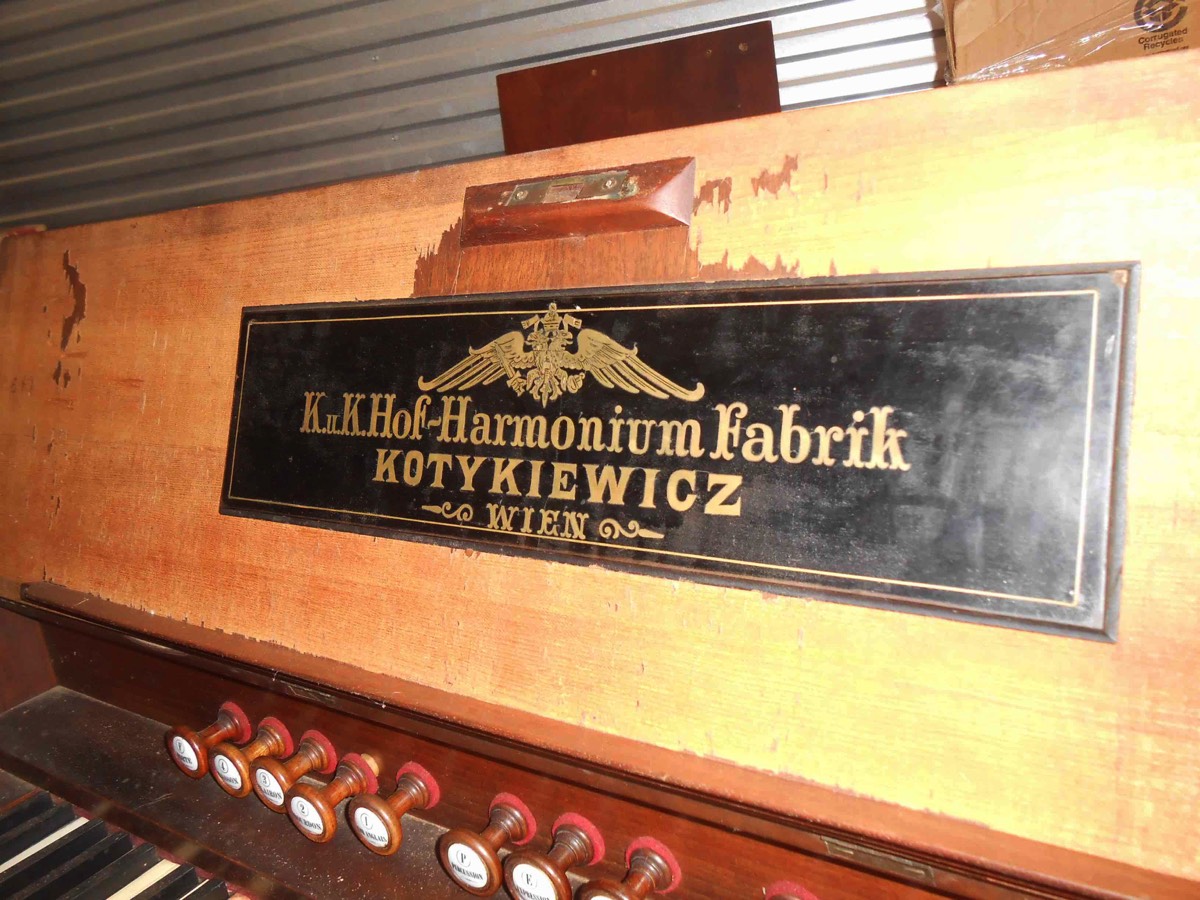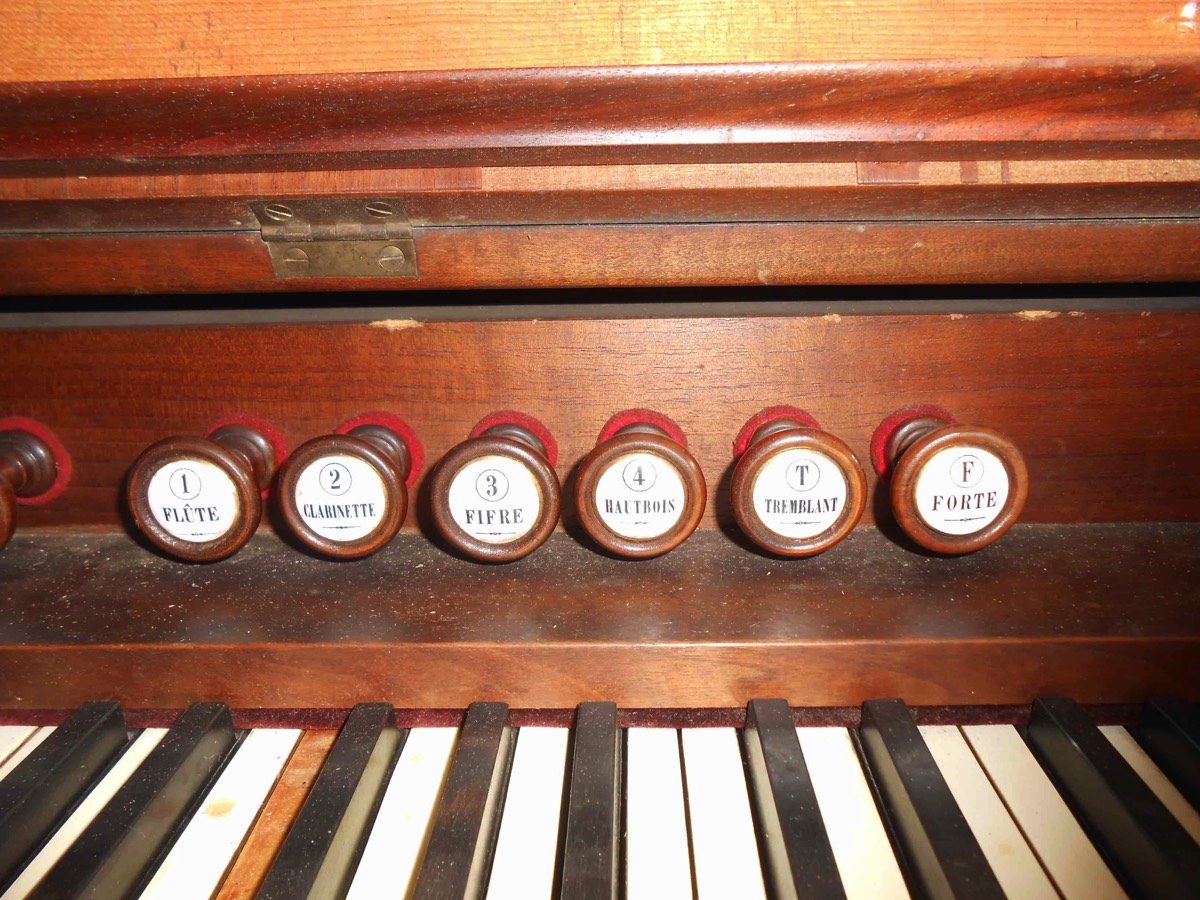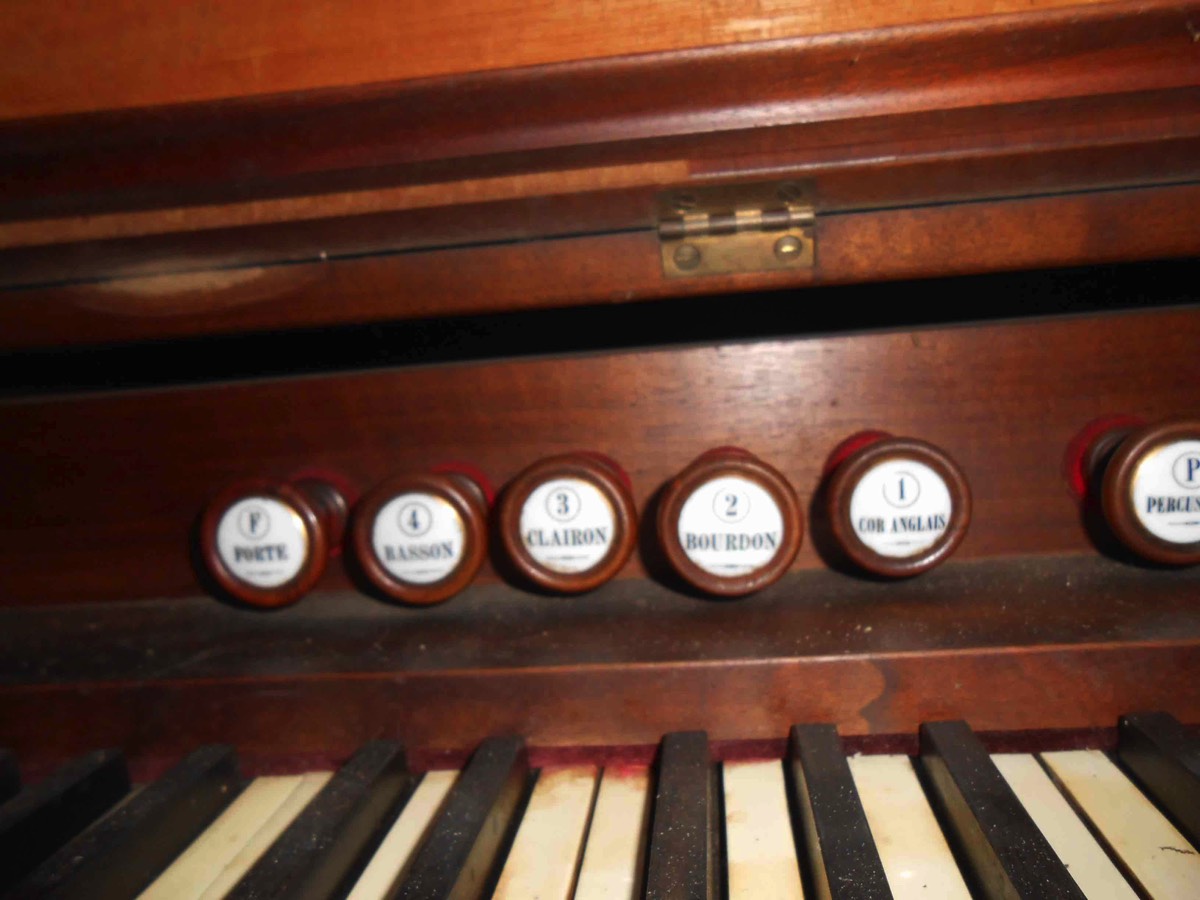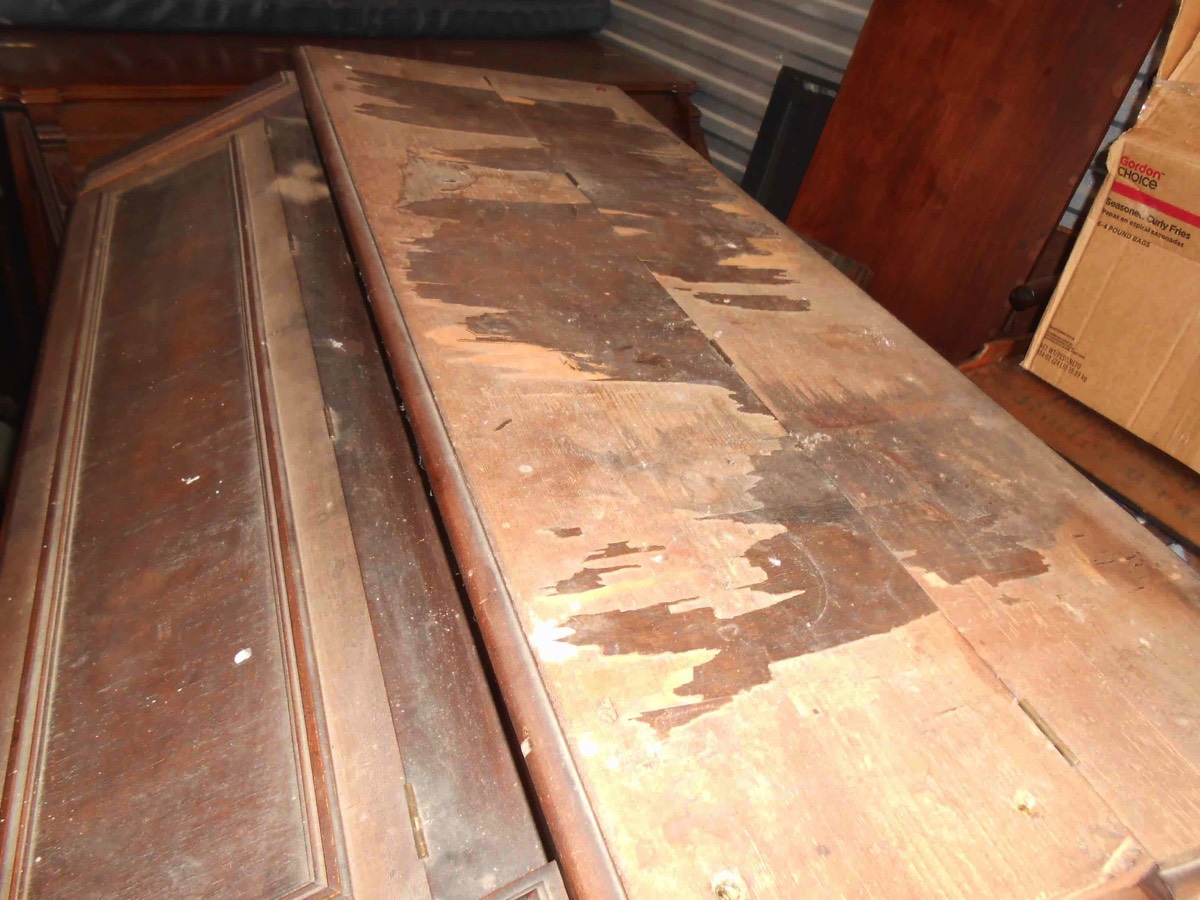Fotos: Stuart McCaskill























Das folgende Instrument mit der Nummer 9462 wurde im Jahre 1911 an Herrn Valentin Huber in San Francisco erstausgeliefert. Es hat vier Stimmen, Perkussion und Prolongement Automat und wurde in Nuss matt gefertigt. Interessant ist, dass Herr Valantin Huber am 04.08.1911 insgesamt vier Instrumente erhalten hat. Schon im Jahre 1909 bekam er ebenfalls drei fast baugleiche Instrumente geliefert. Daher vermute ich, das er ein Instrumentenhändler war. Leider konnte ich bisher noch nichts über den Namen Valentin Huber (San Francisco) heruasfinden.
Das Instrument befindet sich im Besitz von Herrn Stuart McCascil in Kansas City, Missouri USA. Er hat mir eine umfassende Beschreibung und einen Restuarierungsplan geschickt, den ich an dieser Steller gerne wiedergeben möchte:
Aktueller Standort: Vereinigte Staaten - Bundesstaat Missouri - 8124 N Summit St, Kansas City, Missouri 64118
Derzeitiger Eigentümer: Stuart McCaskill
Herkunft: Für 200 USD von einer Familie in Bemidji, Minnesota, gekauft. Das Instrument wurde in einem leerstehenden Haus in Bemidji gefunden, und die neuen Besitzer des Hauses wollten es erhalten. Ein Freund bemerkte es auf dem Facebook-Marktplatz, und ich musste 12 Stunden fahren, um das Instrument zurückzuholen. Bemidji, Minnesota liegt im äußersten Norden der Vereinigten Staaten.
Der Zustand: Das Furnier ist an vielen Stellen abgeblättert oder fehlt. Das Gehäuse ist sehr solide und extrem schwer. Ich würde mindestens 450 Pfund schätzen. Ich bin mir nicht sicher, ob die Griffe original sind, aber ich habe in der letzten ROS-Zeitschrift einen anderen Koty entdeckt, der die gleichen Griffe hat.
Die Zelluloid-Tastatur hat ungewöhnlich abgerundete Kanten und einige Beschädigungen, wie auf dem Bild zu sehen ist. Sie ist einlösbar, aber ich werde Originale erwerben oder ein paar neue Tastenkappen anfertigen müssen. Alle Register aus Porzellan sind vorhanden und erscheinen original. Die Orgel spielt etwas und scheint einen herrlichen Klang zu haben. Die Perkussion ist noch funktionstüchtig. Das gesamte Instrument ist natürlich restaurierungsbedürftig.
Das Gehäuse und die Traktur haben keine Holzwurmschäden. Es ist viel zu kalt für Holzwürmer im Norden oder in Missouri. Wir haben hier keine Holzwürmer. Die Mechanik wirkt sehr trocken und unbelästigt von Mäusen oder Insekten. Ich habe ihn kurz aufgeklinkt und mit Hilfe von hinten hochgehoben, und das Innere ist makellos. Sobald ich herausgefunden habe, wie es sich auflöst, bekomme ich Fotos. Es scheint als ganze Einheit/Baugruppe nach vorne zu schwingen, aber ich bin unsicher und werde dies nicht riskieren, bis ich mir sicher bin.
Aus dem ausgezeichneten, gründlichen Artikel von Herrn Thilo Plaesser in der ROS-Quartalsausgabe XXXIX Nr. 2, 2020, habe ich mir die Kataloge auf seiner Website angesehen. Es scheint, dass ich das 14 Register-Modell 11 Salonharmonium habe. Ich weiß, dass Herr Plaesser bei der Bestimmung dieses Modells sehr hilfreich sein wird. Die auf der Mechanik in der Mitte gestempelte Nummer ist 9462. Ich konnte keine anderen auf der Hülle gestempelten Nummern ausfindig machen. Es ist möglich, dass die Mechanik, sobald sie entfernt ist, irgendwo im Inneren erscheint.
Plan für die Restaurierung: Ich habe 4 oder 5 deutsche Harmonien restauriert, aber es waren spätere Harmonien, die eher wie eine amerikanische Zungenorgel gebaut waren. Ich habe noch nie eine Koty gesehen oder restauriert, aber ich habe über 140 Restaurationen amerikanischer Zungenorgeln durchgeführt. Ich habe auch 12 Klaviere restauriert, so dass ich mit den klavierartigen Mechaniken vertraut bin. Ich werde mich auf Herrn Thilo Plaesser und meinen guten Freund Louis Huivenaar verlassen, wenn es um spezifische Anleitung zu ungewöhnlichen Teilen und Baugruppen geht.
Schritt 1 wird darin bestehen, die Mechanik sicher zu entfernen und auf einen soliden Arbeitstisch zu bringen. Auch das Balgsystem muss sicher entfernt werden.
Schritt 2 Ich muss alle strukturellen Probleme des Falls, einschließlich der Rollen, untersuchen und beheben und die Furniersituation beurteilen. Es gibt auch einige fehlende Zierteile. Mein derzeitiger Gedanke war, das Seitenfurnier, das intakt zu sein scheint, so zu belassen. Ich werde alle anderen Teile entfernen und quer verleimtes Nussbaumfurnier wieder einsetzen. Alles wird passend gebeizt und mit Schellack und Öl bearbeitet.
Schritt 3 - Wiederherstellung des Balgsystems, wobei so nah wie möglich am Originalmaterial gearbeitet wird. Das Balgsystem wieder einbauen und testen.
Schritt 4 - Ich muss die gebrochenen Klaviaturoberflächen reparieren und werde diese Arbeit abschließen, die Zelluloid-Tastatur reinigen und polieren.
Schritt 5 - Wiederherstellung der Mechanik - Ich rechne mit vielen, vielen Arbeitsstunden auf der Werkbank. Sie wird sorgfältig, durchdacht und mit den richtigen Klebstoffen und Materialien durchgeführt werden. Je nach Zustand der Originale werde ich eventuell einen neuen Satz dafür angefertigter Hämmer bestellen müssen.
Schritt 6 - Stimmung - Ich werde sehr vorsichtig sein, um die ursprüngliche Stimmfrequenz zu ermitteln und mich mit Thilo und Louis darüber beraten. Ich habe nicht den Wunsch, in dieser Hinsicht Schaden anzurichten, aber ich bin ein recht fähiger Stimmzungenorgel-Stimmer. Ich möchte, dass die Stimmung genau richtig ist.
Schritt 7 - Spielen, Testen und ggf. Nachbessern der Stimmung nach einigen Wochen des Spielens.
The following instrument with the number 9462 was first delivered to Mr. Valentin Huber in San Francisco in 1911. It has four voices, percussion and prolongement automat and was made in matt walnut. It is interesting that Mr. Valantin Huber received a total of four instruments on 04.08.1911. Already in 1909 he also received three almost identical instruments. Therefore I suspect that he was an instrument dealer. Unfortunately I could not find anything about the name Valentin Huber (San Francisco).
The instrument is owned by Stuart McCascil in Kansas City, Missouri USA. He has sent me a detailed description and a restoration plan, which I would like to reproduce on this site:
Current Location: United States – State of Missouri – 8124 N Summit St, Kansas City, Missouri 64118
Current Owner: Stuart McCaskill
Origin: Purchased for $200 USD from a family in Bemidji, Minnesota. The instrument was found in an empty house in Bemidji and the new owners of the house wished to preserve it. A friend noticed it on Facebook Marketplace and I had to drive 12 hours to retrieve the instrument. Bemidji, Minnesota is on the extreme Northern most part of the United States.
Condition: The veneer is peeling or absent in many places. The case is very solid and extremely heavy. I would estimate 450 pounds, at least. I am uncertain if the handles are original, but I spotted another Koty in the recent ROS journal which has the same handles.
The celluloid keyboard has unusual rounded edges and some damage, as pictured. It is redeemable but I will have to acquire originals or manufacture a few new keytops. All porcelain stops are present and appear original. The organ does play somewhat and appears to have magnificent sound. The percussion is still functional. The entire instrument is in need of restoration, of course.
The case nor action have any woodworm damage. It is far too cold for woodworm in the north or in Missouri. We do not have woodworms here. The action appears very dry and unmolested by mice or insects. I unlatched it briefly and lifted up from the back with help and the interior is spotless. Once I figure out how it comes apart I will get photos. It appears to swing forward as an entire unit/assembly but I am uncertain and will not risk this until I am certain.
From the excellent, thorough article by Mr. Thilo Plaesser in the ROS quarterly XXXIX No. 2, 2020, I reviewed the catalogs on his website. It appears that I have the 14 stop model 11 Salon harmonium. I know that Mr. Plaesser will be greatly helpful in determining this. The number stamped on the action in the center is 9462. I was unable to locate any other numbers stamped inside the case. It is possible that once the action is removed, it may appear inside somewhere.
Plan for Restoration: I have restored 4 or 5 German harmoniums, but they were later ones that were constructed more like an American reed organ. I have never seen or restored a Koty, but I have completed over 140 restorations of American reed organs. I have also restored 12 upright pianos so I am familiar with the piano type actions. I will depend on Mr. Thilo Plaesser and my good friend Louis Huivenaar for specific guidance on unusual parts and assemblies.
Step 1 will be to get the action safely removed and onto a solid work table. The bellows system must also be removed safely.
Step 2 – I need to examine and remediate any case structural issues including casters and to assess the veneer situation. There are also a few missing trim pieces. My current thought it so leave the side veneer which appears intact. I will strip off all other and reinstall cross-banded Walnut veneer. Everything will be stained to match and finished in Shellac and oil.
Step 3 – Restore the bellows system keeping as close as possible to original materials. Reinstall and test bellows system.
Step 4 – I need to remediate the broken keyboard tops and will complete that work, clean and polish the celluloid keyboard.
Step 5 – Action restoration – I anticipate many, many hours of labor on this on the bench. It will be done carefully, thoughtfully and with proper glues and materials. I may have to order a new set of hammers made for it, depending on the condition of the originals.
Step 6 – Tuning – I will be very careful to discover the original tuning frequency and to consult with Thilo and Louis on this. I have no desire to cause any harm in this regard but I am quite a capable reed organ tuner. I want the tuning to be spot on.
Step 7 – Playing, testing and touch up tuning after some weeks of playing, if needed.

